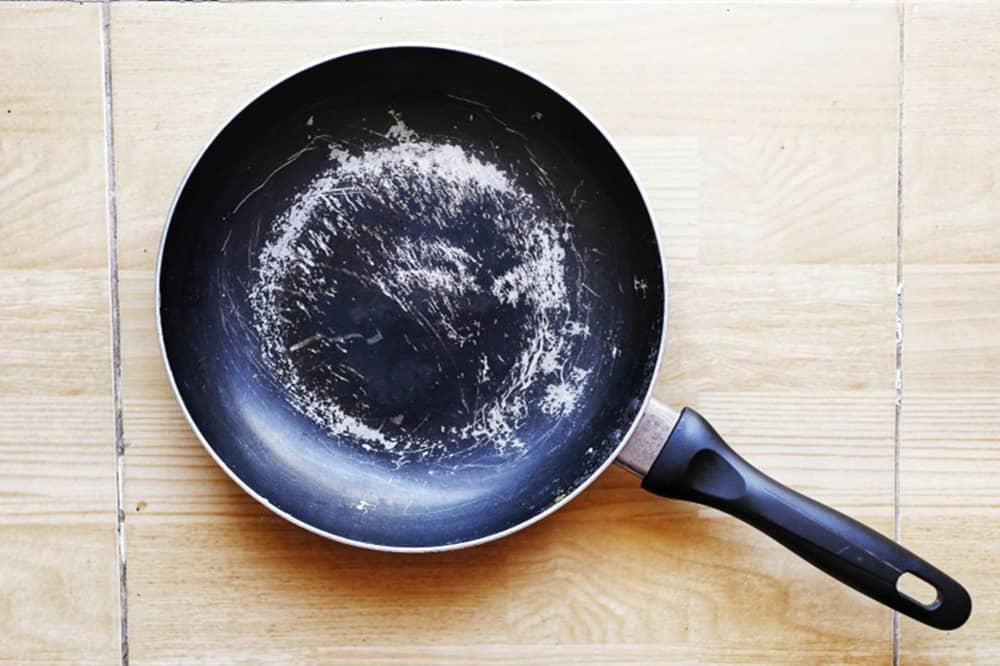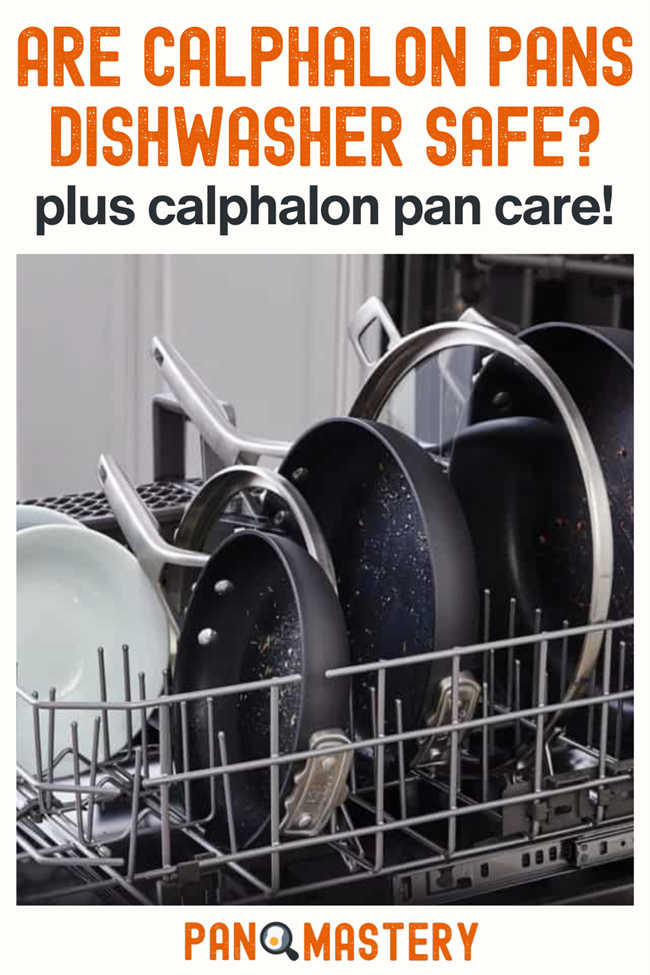Calphalon pans have been getting more popular these past few years since they are praised for their non-stick and easy-to-clean surface. They are durable and scratch-resistant,but are Calphalon pans dishwasher safe?
What are Calphalon Pans?

Calphalon pans are specialized non-stick pans made by the Newell Brand. They have been known to revolutionize non-stick pans since the 1960s.
Their cookware ranges from aluminum, and cast-iron to stainless steel. Calphalon offers a complete series of cookware sets that is fit for any professional or home chef. With that said, they are mostly known for their anodized aluminum pans.
By anodizing the aluminum of the pan, Calphalon pans are protected with a durable coating. The layer of anodic oxygen coat provides the pan with an anti-corrosive finish. The anodized coating is also the one that gives the pans its non-stick coating.
The company is praised for its durable yet less pricey cookware set and utensils. But can they go inside the dishwasher?
Are Calphalon Pans Dishwasher Safe?

To answer the question, most Calphalonpans are dishwasher safe. Unless stated by the manufacturer, they are generally safe to be cleaned with the dishwasher, especially the high-quality ones.
There are a few exceptions, of course. Calphalon pans with ceramic non-stick coating are mostly not for the dishwasher since they have a much more sensitive surface.
Even though they can go inside the dishwasher, it’s not recommended by the professionals. Non-stick pans and dishwashers don’t go together, but why?
Risks Of Putting Pans in the Dishwasher
As stated above, Calphalon pans are mostly made with high-temperature resistance. Their anodized aluminum and stainless steel non-stick pans can withstand 450-500 degrees Fahrenheit.
Even so, there are still a lot of risks when regularly using dishwashers to clean your pan, such as:
Damage to the Coating
Most of the calphalon’s coating is made with a 3-layer non-stick coating. However, it’s stated on the calphalon’s website that the coating is durable. Running the pan through the dishwasher, again and again, can erode the layer over time.
Fortunately, unlike Teflon pans, the anodized aluminum coating of Calphalon pans is PFOA and PTFE-free. You don’t have to worry about poisonous chemicals seeping into your food when you scratch your Calphalon pan. The only problem might be discoloration and the removal of the non-stick capabilities.

Discoloration
Once the surface coating is eroded, the aluminum core of the pan can be exposed to the difficult processes of the dishwasher.
Aluminum and the dishwasher don’t go along together. Once the aluminum core is exposed, it will start to discolor and ruin your pan.
Moisture
Another risk of using a dishwasher with Calphalon pans is the warm moisture of the dishwashers. Dishwashers are especially risky for cast iron skillets since they cannot be harshly cleaned with detergent and water.
Detergent
While the detergent designed for dishwashers can be harsh for some materials of the pan, it’s important to note that stainless steel is generally resistant to bleach and sulfates. However, discoloration and corrosion can still be a risk for other types of materials.
Fortunately, there is a way around this risk. You can use a non-abrasive detergent to minimize the damage to your pans.
Harsh Process
The dishwasher’s cleaning process can lead to your pans’ damage. It’s the combination of heat, water, pressure, and detergent that may erode your pan’s quality over time.
Using the dishwasher from time to time is the best option. Handwash is still recommended to get the best out of your pans.
3 Ways to Know Which Calphalon Pan is Dishwasher Safe

Check the Label
Most Calphalonpans have a dishwasher safe label in the box. You can also check the manufacturer’s website to ensure how to clean your Calphalon pans properly.
You can also look for a dishwasher-safe logo on the box, or the bottom of the pot’s handle. The symbol is commonly drawn as a square logo with plates, glass, and water droplets.
Look at the Manufacturer’s Website
The Calphalon website hosts a lot of information about their pans and other cookware. If you are interested in learning more about your pans, you can read the information here.
Hard Adonized Aluminum Layer
Most high-quality Calphalon pans have a tough adonized aluminum layer. The rugged exterior will provide a layer of protection against the laborious processes of the dishwasher.
Although aluminum is generally considered unsafe for dishwasher cleaning, the anodizing process reinforces the material, making Calphalon pans more resilient to potential dishwasher damage.
Calphalon Pans You Should Try Out
Not so sure if you want to use a Calphalon pan? Here are some pans you can try out. We listed the information that you might want to know. Here are some Calphalon pans you might want to try out without further ado.
Calphalon Premier Non-Stick Cookware Pans

The Calphalon premier cookware set is the most recommended Calphalon pan. The collection has a 3-layer metal construction along with a durable aluminum core.
The pans can stand a temperature of up to 450 degrees Fahrenheit. The pans can stand the oven and dishwasher. Due to its high-temperature capacity, it goes well with gas, induction, and electric stoves. Calphalon also provides a lifetime warranty for the pans.
Calphalon Signature Hard-Anodized Nonstick Pots and Pans, 10-Piece Cookware Set

Another 10-piece signature cookware set from Calphalon is made to be more durable than the classic one. It’s metal-resistant, non-stick, and durable.
The pan can be put in temperatures up to 500 degrees Fahrenheit, so it’s safe in the oven and the dishwasher. The hard gauge coating also provides even heating for a more precise cooking temperature.
The set also has a 3-layer non-stick coating for easier cooking and cleaning.
Calphalon Classic Cookware

The Calphalon Classic Cookware is the cheapest anodized aluminum pan you can get from Calphalon. The pros are mostly the same, albeit less durable than the pan’s definitive version.
Tips on How to Use and Maintain Calphalon Pans
Properly Clean Your Calphalon Pans
Handwashing is still the best way to clean non-stick pans. They limit the laborious processes of cleaning with the dishwasher. There are ways you can better clean your pans. If you are having a hard time, we are here to help you with the step-by-step guide below.
- Cleaning with Detergent and Sponge – If your pan is relatively clean without burning, handwashing with detergent and a non-abrasive sponge will suffice. It’s a straightforward process that you can easily do inside your kitchen without much effort.
- Cleaning with Baking Soda and Vinegar – The baking soda and vinegar cleaning methods are best for Calphalon pans with tough burnt marks or leftover food. To do this method, you need to: Combine equal parts of vinegar and water and pour it into the pan. Let the surface soak for 30 minutes to an hour. The acidic nature of the vinegar will help lift off the burnt marks and sticking food. Once you remove the vinegar, sprinkle a good amount of baking soda. Use a non-abrasive brush to scrub the pan clean gently. Repeat the process until the pan is completely clean.
- Cleaning with Dishwasher – As stated above, you can use dishwashers to clean your Calphalon pans. Follow the instructions provided in your dishwasher, and it will take care of the rest.

Avoid Using Abrasive Utensils
Even though the surface of the Calphalon pans is scratch-resistant, it can’t repel the metal scratching forever.
To protect the coating of your Calphalon pans, you must avoid using metal utensils. You can use bamboo and wood cooking utensils as an alternative.
The non-abrasive wood will minimize the scratching in the non-stick coating and prolong the life of your pans.
Don’t Use Harsh Detergents
Whether you hand wash or use the dishwasher, avoid using harsh detergents. The bleach and sulfates present in harsh kitchen detergents can corrode and discolor your pans.
Don’t Boil the Pan Dry
It would be best if you always keep your eye out when boiling stuff in your Calphalon pans. It’s recommended not to burn the pan dry. The hot moisture will damage and chip off the coating of your pans.
Don’t Use Cooking Sprays
Cooking or aerosol sprays are a no-go for the non-stick coating of the Calphalon pans. The oil will stick to your pan and is hard to remove. It can damage the non-stick feature of your pan.
You don’t even need to use much oil when using Calphalon pans. The anodized surface is designed to keep your food from sticking. Of course, you can still use butter and fats in your food; just don’t use aerosol or canned sprays.
Don’t Change Temperatures Too Quickly
Avoid putting your pans to cold to hot or hot to cold temperatures instantly. The sudden change might cause cracks and damage, not just the coating but also the core itself.
In Conclusion
Like other cookware, Calphalon pans need extensive and proper maintenance to get the best out of your money. With proper care and commitment, you can have a pan that can last for a very long time.
We hope these articles helped you take better care of your cookware. If you have more questions about cookware, comment down below.


Michael Johnson is the founder of Pan Mastery, Inspired by his blacksmith grandfather’s legacy has a deep appreciation for hand-crafted pots and pans, he provides invaluable guides, reviews, and recipes to enhance your culinary journey.
